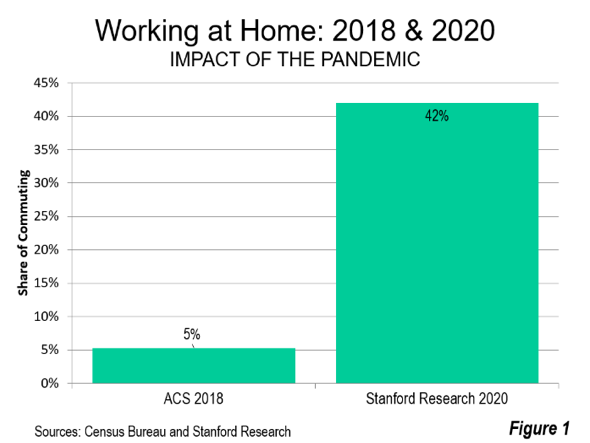
One of the most significant effects of the COVID-19 pandemic has been a large increase in remote work. The ability to work from home has rescued the U.S. and the world from a steeper economic decline. Fortunately, information technology made it possible for a much larger part of the economy to continue working than otherwise would have been possible.
Well before the pandemic, remote work had been increasing strongly, capturing 13 percent of new US employment since 2010, three times its 2010 share. By 2017 there were more remote workers than transit commuters.
By 2019, outside the unique city of New York, remote workers outnumbered those riding transit by two-thirds.
Several notable companies have embraced working from home until the pandemic ends—and beyond, including Google, Microsoft, Twitter, Nationwide Insurance, and others. There is evidence that remote workers can be more productive.
While lockdowns have been a key factor in the shift to remote work, personal health concerns may have played an even more critical role. For example, in Japan, which did not implement lockdowns, and has a low rate of infections, commuting to the two densest urban cores of Tokyo and Osaka “slowed to a trickle” as people avoided enclosed spaces like transit, elevators, and choices which can be risky without sufficient ventilation.
According to a Stanford University study, 42 percent of workers are now working from home—eight times the pre-pandemic 5.3 percent reported by the American Community Survey (ACS) in 2018 (see Figure 1). According to a large national IBM poll, 54 percent would like to continue working from home after the pandemic, while 75 percent would like the option of working from home occasionally.

For all commuters the gains can be substantial, with daily travel time savings averaging nearly one hour. For commuter rail riders, the savings can reach 2.5 hours. Meanwhile, a large permanent increase in remote work could reduce traffic congestion and speed commuting for those who still drive.
Of course, how much remote work will remain post-COVID is yet to be seen. What should governments do? Fundamentally: seek to facilitate people’s preferences. Governments and planning agencies will not convince people to sacrifice their health security any more than other proposals over the past half-century to shift drivers away from cars to transit and bicycles.
As former World Bank principal planner Alain Bertaud said during a Melbourne (Australia) webinar, the job of planners is to “keep their ears to the ground,” and to understand and respond to what is happening rather than try to maneuver the public into a pre-COVID ideal.
The pandemic could lead permanently to far more telework and an exodus from urban cores, driven by factors inherent to areas of high density, such as the inability to maintain economic activity, with social distancing requirements and fears for personal safety, especially in overcrowded, enclosed spaces (see here and here). Moreover, sufficient resilience for future pandemics requires urbanization of lower densities.
What States Can Do
- Repeal Urban Containment Policies: Government and planning agencies should repeal urban containment and forced densification policies becase they could be rendered irrelevant or counterproductive as households chose greater dispersion.
- Suspend Long-Range Transportation Planning: Long-range transportation planning efforts should be suspended until such time as the longer term residential and commuting impacts of COVID are clear.
The newly published Demographia International Housing Affordability 2021 Edition stresses the potential for improving middle-income housing affordability as remote working increases. In this regard, Irish Minister for Enterprise, Trade and Employment Leo Varadkar noted in releasing the new National Remote Work Strategy:
The pandemic has changed our world. It has also changed the world of work forever. Millions of people and businesses around the world had to change overnight moving from the office to home working and from interactions that occurred in person to interactions that occurred mainly on-line. This shift might have taken decades if it had been planned. Instead it took days.
The Strategy goes on to suggest that: “Remote work also provides the opportunity to relieve accommodation pressures in cities where demand has caused rent and house prices to increase significantly above the national average.” Similar conclusions were published in a Federal Reserve Bank of Kansas City economic report and an article in The Atlantic. The Irish Strategy also highlighted the opportunity to reduce auto commuting, which has been increasing “strongly.”
Note: This article is adapted from "Consider the Role of Working from Home" in Transportation and COVID-19: A State Guide to Policy and Priorities, which was coordinated by Mariya Frost, Director of the Coles Center for Transportation at the Washington Policy Institute. Also available at the Reason Foundation.
Wendell Cox is principal of Demographia, an international public policy firm located in the St. Louis metropolitan area. He is a founding senior fellow at the Urban Reform Institute, Houston and a member of the Advisory Board of the Center for Demographics and Policy at Chapman University in Orange, California. He has served as a visiting professor at the Conservatoire National des Arts et Metiers in Paris. His principal interests are economics, poverty alleviation, demographics, urban policy and transport. He is co-author of the annual Demographia International Housing Affordability Survey and author of Demographia World Urban Areas.
Mayor Tom Bradley appointed him to three terms on the Los Angeles County Transportation Commission (1977-1985) and Speaker of the House Newt Gingrich appointed him to the Amtrak Reform Council, to complete the unexpired term of New Jersey Governor Christine Todd Whitman (1999-2002). He is author of War on the Dream: How Anti-Sprawl Policy Threatens the Quality of Life and Toward More Prosperous Cities: A Framing Essay on Urban Areas, Transport, Planning and the Dimensions of Sustainability.
Lead image: Amitchell125, chart of World Work at Home percentage via Wikimedia under CC 4.0 License.












